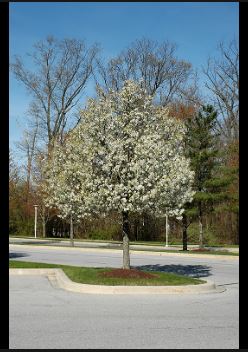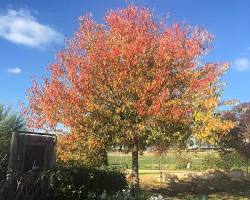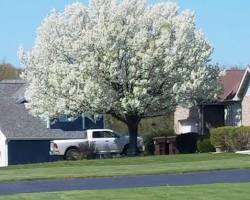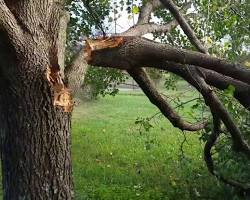The Aristocrat pear tree (Pyrus calleryana ‘Aristocrat’) is a popular ornamental tree recognised for its stunning white blossoms in the spring and colourful red-orange fall foliage. While it’s a pretty new cultivar, having been brought within the 1960s, it has quickly received reputation because of its ease of care, adaptability to diverse climates, and universal aesthetic enchantment.
| Pros | Cons |
|---|---|
| Beautiful Blossoms and Fall Foliage | Susceptible to Structural Weaknesses |
| Adaptable to Various Climates | Short Lifespan |
| Fast-Growing and Easy to Care For | Potential for Messy Fruit |
| Provides Shade and Structure | Limited Root Structure |
| Attracts Wildlife | Potential for Invasive Spread |
PRO: Beautiful Blossoms and Fall Foliage
The Aristocrat pear tree is a showstopper in every experience of the word. Each spring, this tree comes alive with an abundance of delicate, fragrant white blossoms. These blossoms are not simply aesthetically captivating but additionally serve an vital ecological reason by means of attracting pollinators like bees and butterflies. The presence of these pollinators contributes to the general health of your lawn, making sure the successful replica of other plant life as nicely.
As the seasons transition, the Aristocrat pear tree continues to captivate with its exquisite fall foliage. The leaves steadily transform right into a breathtaking array of purple-orange colours, providing a striking contrast towards the backdrop of autumn’s earthy tones. This beautiful display adds a touch of beauty and vibrancy on your garden, making it a true centerpiece of your panorama.
PRO: Adaptable to Various Climates
One of the Aristocrat pear tree’s standout features is its adaptability to a wide range of climates. This cultivar flourishes in USDA hardiness zones 5-nine, encompassing a enormous portion of america. Whether you reside in a hot and arid place or a cooler, greater temperate region, the Aristocrat pear tree can find a comfortable home to your garden.
Moreover, this tree presentations an impressive tolerance for various soil types, along with clay, loam, and sand. Once hooked up, it well-knownshows drought resistance, decreasing the want for steady watering and maintenance. This adaptability guarantees that the Aristocrat pear tree can flourish and thrive in various environments, making it a flexible preference for gardeners throughout the united states of america.
PRO: Fast-Growing and Easy to Care For
Gardening enthusiasts, each novices and pro specialists, respect the ease of worrying for the Aristocrat pear tree. This cultivar is famend for its speedy growth, achieving maturity in about 15-two decades. This way that you can revel in the tree’s beauty and benefits especially quickly after planting it in your garden.
Additionally, the Aristocrat pear tree’s low-protection nature reduces the workload required to preserve it healthy and vibrant. Unlike a few high-preservation tree species, this cultivar demands minimum pruning and fertilization. It also boasts resistance to maximum not unusual pests and illnesses, decreasing the need for chemical remedies which could harm your lawn’s surroundings. With the Aristocrat pear tree, you could enjoy a lovely addition on your landscape with out the stress of consistent upkeep.
PRO: Provides Shade and Structure
As the Aristocrat pear tree matures, it undergoes a transformation that advantages each you and your garden. It develops a dense, rounded cover that offers a lot-needed color all through the scorching summer season months. This coloration serves as a shelter, presenting relief from the sun’s severe rays for you, your family, and any plant life to your lawn that may be liable to warmness stress.
Moreover, the tree’s fashionable pyramidal form provides a touch of visual hobby and shape for your landscape. Whether used as a focal point in a lawn design or as a coloration-supplying sentinel in a park or commercial setting, the Aristocrat pear tree adds an element of elegance and sophistication to any environment.
PRO: Attracts Wildlife
Gardens are not only for humans; they play a important function in assisting local ecosystems. The Aristocrat pear tree is familiar with this and acts as a magnet for wildlife. Its blossoms and small, inedible end result are irresistible to lots of creatures, improving the biodiversity of your garden.
Bees and butterflies are interested in the tree’s aromatic blooms, contributing to the pollination of different vegetation in your lawn. These pollinators play a crucial function in keeping a healthy atmosphere and promoting the increase of fruits, greens, and vegetation. By planting an Aristocrat pear tree, you’re not simplest adding beauty to your panorama however also fostering the vitality of the natural international round you.
Birds are also enticed with the aid of the Aristocrat pear tree’s offerings. While the tree’s culmination are not appropriate for human consumption, they offer a precious food source for birds at some stage in the colder months. This can entice a numerous range of hen species to your garden, growing a captivating symphony of avian activity.
CON: Susceptible to Structural Weaknesses
One of the number one issues when it comes to the Aristocrat pear tree is its susceptibility to structural weaknesses. These weaknesses frequently manifest within the crotch region in which branches meet. While the tree is usually taken into consideration hardy, it is able to be vulnerable to department breakage, specifically for the duration of extreme climate events together with storms, heavy snow fall, or sturdy winds.
To mitigate this hazard, everyday pruning and upkeep are important. Trimming the tree’s branches and ensuring a properly-balanced cover can assist support its structural integrity. While this does require extra effort, it is a important precaution to save you capability harm to your home or damage to people on your lawn.
CON: Short Lifespan
Compared to a few other tree species, the Aristocrat pear tree has a noticeably brief lifespan, normally lasting around 20-25 years. While this will not be a huge drawback for plenty gardeners, it’s essential to be conscious that the tree’s presence on your panorama may be quite short-lived. Planning for eventual replacement or succession planting may be vital if you need to keep the tree’s function as a focus or shade issuer to your lawn.
CON: Potential for Messy Fruit
The Aristocrat pear tree produces small, inedible end result that may linger on the tree for the duration of the iciness months. While these fruits are not supposed for human consumption, they can create a potentially messy state of affairs on your garden. Additionally, the presence of those culmination can entice unwanted pests, consisting of fruit flies, which can be a nuisance.
To deal with this issue, ordinary smooth-up and protection may be required to hold your garden tidy and pest-loose. This extra attempt should be factored into your normal lawn care routine.

CON: Limited Root Structure
The Aristocrat pear tree is characterised by way of a shallow, spreading root system. While this root structure will have its benefits, consisting of facilitating planting in shallow soils or close to the floor, it may also pose demanding situations. Trees with shallow root systems are greater at risk of wind damage, in particular in areas at risk of robust winds or storms.
Furthermore, the shallow roots can potentially disrupt hardscape features like sidewalks, driveways, and foundations. Proper making plans and location of the tree are vital to avoid those problems. Care should be taken to keep away from planting it too close to structures or pathways to prevent potential troubles within the future.
CON: Potential for Invasive Spread
In a few regions, the Aristocrat pear tree has exhibited competitive spreading conduct thru suckers or seedlings. This can bring about the tree establishing itself in regions where it is not desired, doubtlessly crowding out local flowers and disrupting nearby ecosystems.
Before planting the Aristocrat pear tree, it is critical to analyze and take a look at with local authorities or gardening specialists to decide whether or not it poses a risk of invasive unfold on your particular region. If there are worries about its capability invasiveness, you could need to consider opportunity tree species which might be extra suitable in your area.
In summary, at the same time as the Aristocrat pear tree offers severa advantages for gardeners and house owners, which includes its lovely look, adaptability, and flora and fauna appeal, it isn’t always without its challenges. These include capacity structural weaknesses, a especially short lifespan, messy fruit, limited root structure, and the threat of invasive spread in sure areas. By cautiously thinking about these execs and cons, you can make an informed selection approximately whether or not the Aristocrat pear tree is the right choice in your lawn and landscape wishes.
Characteristics of the Aristocrat Pear Tree
The Aristocrat pear tree (Pyrus calleryana ‘Aristocrat’) belongs to the Rosaceae family and is a fascinating decorative tree renowned for its picturesque blossoms and vibrant fall foliage. With its slender pyramidal shape and rapid growth rate, this tree provides a touch of beauty and grandeur to any panorama.
Key Features:
- Botanical Name: Pyrus calleryana ‘Aristocrat’
- Common Name: Aristocrat pear tree, Callery pear tree
- Hardiness Zones: USDA five to nine
- Mature Height: 25 to 30 feet
- Spread: 20 to twenty-five toes
- Growth Rate: Fast, reaching maturity in 15 to 20 years
- Flower Color: Fragrant white blooms in early spring
- Bloom Time: Late March to early April
- Fall Foliage Color: Stunning red-orange colorations in autumn
- Fruit: Small, inedible fruits persisting thru iciness
Benefits of Aristocrat Pear Trees
Visual Appeal: The Aristocrat pear tree is a visual pride at some point of the seasons. Its white blossoms in spring remodel right into a fiery show of purple-orange foliage in autumn, growing a charming spectacle in the panorama.
Adaptability: This tree flourishes in numerous climates, from temperate regions to people with moderate winters. It can tolerate a huge range of soil sorts, which includes clay, loam, and sandy soils, and is moderately drought-tolerant once installed.
Low-Maintenance Care: The Aristocrat pear tree is fairly clean to take care of. It requires minimum pruning, fertilizing, and pest manipulate, making it suitable for both experienced and newbie gardeners.
Shade Provider: As the tree matures, its dense canopy presents adequate colour, growing a groovy and enjoyable retreat all through hot summer days.
Wildlife Magnet: The Aristocrat pear tree’s blossoms appeal to bees, butterflies, and other pollinators, improving the ecological stability of the encircling environment. Additionally, its small, inedible fruits function food for birds during the winter months.
Drawbacks of Aristocrat Pear Trees
Structural Weaknesses: The Aristocrat pear tree is at risk of structural weaknesses, specially at branch crotches. This can lead to branch breakage all through harsh climate situations.
Short Lifespan: This tree has a notably brief lifespan, generally lasting round 20 to 25 years. Replacing it can be essential earlier than different tree species.
Messy Fruit: The Aristocrat pear tree produces small, inedible culmination that persist on the tree for the duration of the iciness. These end result can grow to be ugly and appeal to undesirable pests, such as fruit flies.
Shallow Root System: This tree has a shallow, spreading root system, which makes it more susceptible to wind harm and can cause issues with sidewalks or driveways.
Potential Invasive Spread: In a few areas, the Aristocrat pear tree has been acknowledged to spread aggressively through suckers or seedlings. It’s critical to test nearby guidelines concerning invasive species before planting this tree.
Comprehensive Care Guidelines for Aristocrat Pear Trees
Planting Location: Select a planting website online that offers enough space for the tree to mature without restricting its increase or interfering with nearby structures. Consider the mature top and spread of the tree whilst choosing the planting region.
Watering: Newly planted Aristocrat pear timber require normal watering to establish a strong root system. Once set up, the tree turns into more drought-tolerant but nonetheless blessings from everyday watering all through dry periods.
Pruning: Regular pruning is crucial for maintaining the tree’s shape and stopping overcrowding of branches. Prune at some stage in the dormant season (winter or early spring) to limit pressure on the tree.
Fertilizing: An annual software of balanced fertilizer at some stage in the spring can sell healthy growth and flowering. Follow the encouraged dosage and application agenda for the unique fertilizer you choose.
Pest and Disease Control: Monitor the tree for symptoms of pests or sicknesses, which include aphids, scale insects, or fungal sicknesses. Take suitable movement if essential, the use of organic or traditional pest manipulate methods.
Winter Protection: In regions with harsh winters, recollect supplying extra wintry weather safety for the tree’s delicate branches. Apply a protecting wrap or mulch across the base of the tree to shield it from excessive bloodless temperatures.
Read Next : Green Ash Tree Pros and Cons



